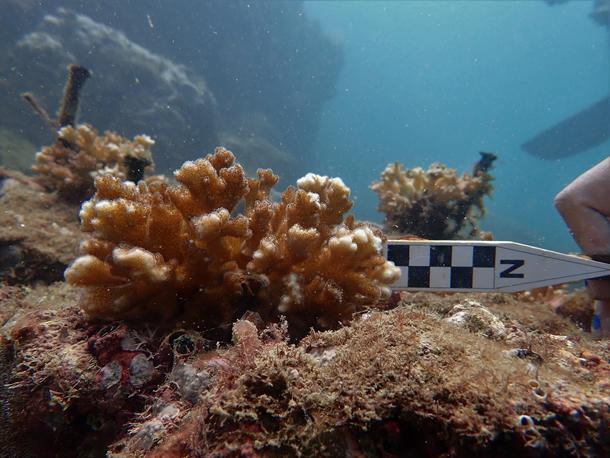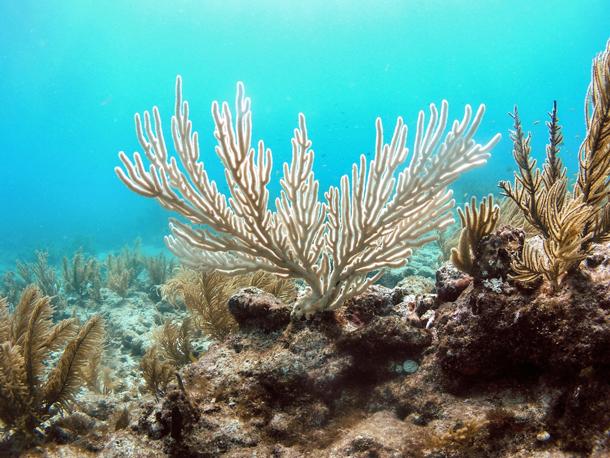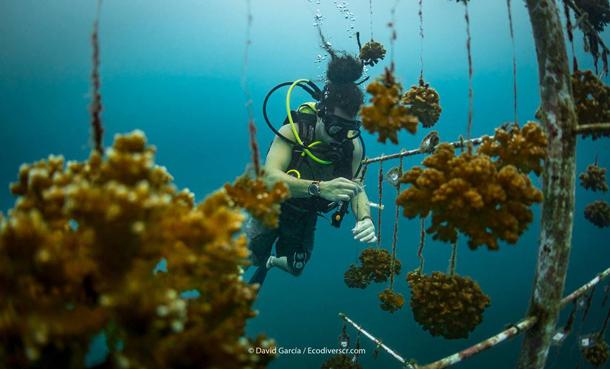Transplanting resilient corals may help them survive climate change
A diver with Raising Coral Costa Rica tends to a floating garden of Pocillopora corals.
More than half the world’s coral reefs have died in the last few decades and scientists predict that as many as 90% could die off this century as the ocean chemistry changes and temperatures rise. But some coral populations are actually thriving in warmer waters and scientists are working to speed up natural selection by propagating these resilient corals.
Joanie Kleypas, a senior scientist at the National Center for Atmospheric Research and founder of the nonprofit Raising Coral Costa Rica, says results so far have been encouraging.
“It’s remarkable, really,” she says. “You take these small samples of coral, you put them in the nursery and … they really want to grow. Some of these corals look bad when you collect them and then you put them in this really nice environment and they grow like crazy. It’s really a fulfilling experience to see that.”

Kleypas says scientists are speeding up by about five times or more what the corals would do naturally. When coral populations drop to such low levels, the eggs and sperm they release into the water column in order to reproduce have a low probability of finding each other, “but if we can go into some of these areas and plant thousands of these corals of different genotypes, when they spawn, they will find each other,” she explains. “That sort of brings them past this threshold of having such low numbers to a point where they can become self-sustaining again.”
Related: A successful coral transplant gives scientists hope for the Great Barrier Reef
Kleypas works mainly on the Pacific Ocean side of Costa Rica. On the Atlantic Ocean side, scientists are engaged in similar work with endangered coral species, in particular, the staghorn and elkhorn corals, she says. They’ve successfully brought some of these corals back and increased the genetic diversity of corals in their nurseries. Scientists have also seen good results in the Caribbean.

Kleypas likes working on the Pacific side of Costa Rica because “even though there are just a few species, they’re really tough there.”
“They’re tough because they have to be,” she says. “It’s kind of a harsh environment. The temperatures can be quite extreme, the pH of the water is pretty low, and yet they thrive. And if you’re going to propagate species for the future, you need to find those tough corals.”
Scientists are also looking into transplanting resilient corals from one part of the ocean to another, but this intervention comes with high risks. “When you move corals around, you move around not just the coral, you move around the bacteria that it has on it; you move around all these other species that live on the coral,” Kleypas explains. “So, there’s a risk of introducing invasive species or diseases. You have to be really careful about moving them around.”
But researchers are finding ways to get around this problem — for example, by freezing eggs and sperm. In a recent project, scientists were able to produce viable offspring by fertilizing the eggs of a coral with sperm transported from the other side of the world. “That eliminated the bringing of invasive species,” Kleypas says. “If you’re just bringing the sperm, that eliminates that probability. So there are some really cool and innovative ways that people are figuring out how to deal with these risks.”
Scientists are also experimenting with genetic modification of corals, which can be done in two ways. One is the “natural way,” by crossbreeding corals as humans have always done with crops and flowers. The other is by using new laboratory genetic techniques.
“That scares a lot of people. I think we need to be careful about that,” Kleypas says. “I don’t think we’re going to be in danger of creating Frankenstein corals. Most of the genetic studies that are going on now are designed to understand what’s going on inside the coral when it is adapting to a temperature change. How do we understand what’s happening to that coral by looking at its genetics, rather than trying to change the coral with the genetics? But it is something in the toolbox that needs to be evaluated along with the risk before we use that kind of technique.”
Related: After Maria, local NGOs repair Puerto Rico’s coral reefs
The Earth’s corals have “had their ups and downs through geologic history,” Kleypas says, but they always seem to come back. Corals experienced a big wipeout when the dinosaurs went extinct and again, 10 million years later, when the Earth underwent a “high CO2, high ocean acidification event.”
“But most of those changes have been a lot slower than what we’re seeing today. That’s the problem,” Kleypas says. “We know corals … have a huge capacity for adaptation. But right now, it’s just too fast. It’s faster than they can do it themselves. We are having to become part of that ecosystem to help speed up the rate at which they can adapt.”
This article is based on an interview that aired on PRI’s Living on Earth with Steve Curwood.
